Structure of the Flight Muscle Thick Filament from the Bumble Bee, Bombus ignitus, at 6 Å Resolution
Abstract
1. Introduction
2. Results
2.1. Myosin Tail Structure and Arrangement
2.2. Coiled Coils and Skip Residues
2.3. Myosin Heads
2.4. Non-Myosin Densities
2.4.1. Flightin
2.4.2. Myofilin
2.4.3. Paramyosin
2.5. Protein Identification and Quantification by Mass Spectrometry
2.6. Atomic Model Fitting
3. Discussion
3.1. The General Features of Asynchronous Flight Muscle Thick Filaments
3.2. Nonmyosin Densities
3.3. The Disordered Myosin Heads
3.4. Effect of Disordered Myosin Heads on Stretch Activation
3.5. The Disordered Myosin Heads Effect on Muscle Temperature
4. Materials and Methods
4.1. Thick Filament Preparation
4.2. Grid Preparation
4.3. Data Collection
4.4. Data Analysis
4.5. Protein Identification and Quantification by Mass Spectrometry
4.6. Protein Sequence Comparison
Supplementary Materials
Author Contributions
Funding
Institutional Review Board Statement
Informed Consent Statement
Data Availability Statement
Acknowledgments
Conflicts of Interest
References
- Woodhead, J.L.; Zhao, F.-Q.; Craig, R.; Egelman, E.H.; Alamo, L.; Padrón, R. Atomic Model of a Myosin Filament in the Relaxed State. Nature 2005, 436, 1195–1199. [Google Scholar] [CrossRef] [PubMed]
- Wendt, T.; Taylor, D.; Trybus, K.M.; Taylor, K. Three-Dimensional Image Reconstruction of Dephosphorylated Smooth Muscle Heavy Meromyosin Reveals Asymmetry in the Interaction between Myosin Heads and Placement of Subfragment 2. Proc. Natl. Acad. Sci. USA 2001, 98, 4361–4366. [Google Scholar] [CrossRef] [PubMed]
- Zoghbi, M.E.; Woodhead, J.L.; Moss, R.L.; Craig, R. Three-Dimensional Structure of Vertebrate Cardiac Muscle Myosin Filaments. Proc. Natl. Acad. Sci. USA 2008, 105, 2386–2390. [Google Scholar] [CrossRef] [PubMed]
- Zhao, F.-Q.; Craig, R.; Woodhead, J.L. Head–Head Interaction Characterizes the Relaxed State of Limulus Muscle Myosin Filaments. J. Mol. Biol. 2009, 385, 423–431. [Google Scholar] [CrossRef]
- AL-Khayat, H.A.; Kensler, R.W.; Squire, J.M.; Marston, S.B.; Morris, E.P. Atomic Model of the Human Cardiac Muscle Myosin Filament. Proc. Natl. Acad. Sci. USA 2013, 110, 318–323. [Google Scholar] [CrossRef]
- Woodhead, J.L.; Zhao, F.-Q.; Craig, R. Structural Basis of the Relaxed State of a Ca2+-Regulated Myosin Filament and Its Evolutionary Implications. Proc. Natl. Acad. Sci. USA 2013, 110, 8561–8566. [Google Scholar] [CrossRef]
- Sulbarán, G.; Alamo, L.; Pinto, A.; Márquez, G.; Méndez, F.; Padrón, R.; Craig, R. An Invertebrate Smooth Muscle with Striated Muscle Myosin Filaments. Proc. Natl. Acad. Sci. USA 2015, 112, E5660–E5668. [Google Scholar] [CrossRef]
- Hu, Z.; Taylor, D.W.; Reedy, M.K.; Edwards, R.J.; Taylor, K.A. Structure of Myosin Filaments from Relaxed Lethocerus Flight Muscle by Cryo-EM at 6 Å Resolution. Sci. Adv. 2016, 2, e1600058. [Google Scholar] [CrossRef]
- Naber, N.; Cooke, R.; Pate, E. Slow Myosin ATP Turnover in the Super-Relaxed State in Tarantula Muscle. J. Mol. Biol. 2011, 411, 943–950. [Google Scholar] [CrossRef]
- Lee, K.H.; Sulbarán, G.; Yang, S.; Mun, J.Y.; Alamo, L.; Pinto, A.; Sato, O.; Ikebe, M.; Liu, X.; Korn, E.D.; et al. Interacting-Heads Motif Has Been Conserved as a Mechanism of Myosin II Inhibition since before the Origin of Animals. Proc. Natl. Acad. Sci. USA 2018, 115, E1991–E2000. [Google Scholar] [CrossRef]
- Trivedi, D.V.; Adhikari, A.S.; Sarkar, S.S.; Ruppel, K.M.; Spudich, J.A. Hypertrophic Cardiomyopathy and the Myosin Mesa: Viewing an Old Disease in a New Light. Biophys. Rev. 2018, 10, 27–48. [Google Scholar] [CrossRef] [PubMed]
- Padrón, R.; Dutta, D.; Craig, R. Variants of the Myosin Interacting-Heads Motif. J. Gen. Physiol. 2023, 155, e202213249. [Google Scholar] [CrossRef] [PubMed]
- Daneshparvar, N.; Taylor, D.W.; O’Leary, T.S.; Rahmani, H.; Yeganeh, F.A.; Previs, M.J.; Taylor, K.A. CryoEM Structure of Drosophila Flight Muscle Thick Filaments at 7Å Resolution; Biophysics; Life Science Alliance LLC: Heidelberg, Germany, 2020. [Google Scholar]
- Yeganeh, F.A.; Rastegarpouyani, H.; Taylor, K.A. High Resolution Cryo-EM Structure of Drosophila Thick Filaments. Microsc. Microanal. 2022, 28, 1102–1103. [Google Scholar] [CrossRef]
- Grant, T.; Rohou, A.; Grigorieff, N. CisTEM, User-Friendly Software for Single-Particle Image Processing. eLife 2018, 7, e35383. [Google Scholar] [CrossRef] [PubMed]
- Punjani, A.; Rubinstein, J.L.; Fleet, D.J.; Brubaker, M.A. CryoSPARC: Algorithms for Rapid Unsupervised Cryo-EM Structure Determination. Nat. Methods 2017, 14, 290–296. [Google Scholar] [CrossRef] [PubMed]
- Squire, J.M. General Model of Myosin Filament Structure. J. Mol. Biol. 1973, 77, 291–323. [Google Scholar] [CrossRef]
- Lowey, S.; Trybus, K.M. Common Structural Motifs for the Regulation of Divergent Class II Myosins. J. Biol. Chem. 2010, 285, 16403–16407. [Google Scholar] [CrossRef]
- Zivanov, J.; Nakane, T.; Forsberg, B.O.; Kimanius, D.; Hagen, W.J.; Lindahl, E.; Scheres, S.H. New Tools for Automated High-Resolution Cryo-EM Structure Determination in RELION-3. eLife 2018, 7, e42166. [Google Scholar] [CrossRef]
- Pettersen, E.F.; Goddard, T.D.; Huang, C.C.; Couch, G.S.; Greenblatt, D.M.; Meng, E.C.; Ferrin, T.E. UCSF Chimera-A Visualization System for Exploratory Research and Analysis. J. Comput. Chem. 2004, 25, 1605–1612. [Google Scholar] [CrossRef]
- Rahmani, H.; Ma, W.; Hu, Z.; Daneshparvar, N.; Taylor, D.W.; McCammon, J.A.; Irving, T.C.; Edwards, R.J.; Taylor, K.A. The Myosin II Coiled-Coil Domain Atomic Structure in Its Native Environment. Proc. Natl. Acad. Sci. USA 2021, 118, e2024151118. [Google Scholar] [CrossRef]
- Blankenfeldt, W.; Thomä, N.H.; Wray, J.S.; Gautel, M.; Schlichting, I. Crystal Structures of Human Cardiac β-Myosin II S2-Δ Provide Insight into the Functional Role of the S2 Subfragment. Proc. Natl. Acad. Sci. USA 2006, 103, 17713–17717. [Google Scholar] [CrossRef] [PubMed]
- Lippert, L.G.; Dadosh, T.; Hadden, J.A.; Karnawat, V.; Diroll, B.T.; Murray, C.B.; Holzbaur, E.L.F.; Schulten, K.; Reck-Peterson, S.L.; Goldman, Y.E. Angular Measurements of the Dynein Ring Reveal a Stepping Mechanism Dependent on a Flexible Stalk. Proc. Natl. Acad. Sci. USA 2017, 114, E4564–E4573. [Google Scholar] [CrossRef] [PubMed]
- Hooper, S.L.; Hobbs, K.H.; Thuma, J.B. Invertebrate Muscles: Thin and Thick Filament Structure; Molecular Basis of Contraction and Its Regulation, Catch and Asynchronous Muscle. Prog. Neurobiol. 2008, 86, 72–127. [Google Scholar] [CrossRef]
- Jumper, J.; Evans, R.; Pritzel, A.; Green, T.; Figurnov, M.; Ronneberger, O.; Tunyasuvunakool, K.; Bates, R.; Žídek, A.; Potapenko, A.; et al. Highly Accurate Protein Structure Prediction with AlphaFold. Nature 2021, 596, 583–589. [Google Scholar] [CrossRef]
- Ferguson, C.; Lakey, A.; Hutchings, A.; Butcher, G.W.; Leonard, K.R.; Bullard, B. Cytoskeletal Proteins of Insect Muscle: Location of Zeelins in Lethocerus Flight and Leg Muscle. J. Cell Sci. 1994, 107 Pt 5, 1115–1129. [Google Scholar] [CrossRef] [PubMed]
- Tanner, B.C.W.; Miller, M.S.; Miller, B.M.; Lekkas, P.; Irving, T.C.; Maughan, D.W.; Vigoreaux, J.O. COOH-Terminal Truncation of Flightin Decreases Myofilament Lattice Organization, Cross-Bridge Binding, and Power Output in Drosophila Indirect Flight Muscle. Am. J. Physiol.-Cell Physiol. 2011, 301, C383–C391. [Google Scholar] [CrossRef]
- Soto-Adames, F.N.; Alvarez-Ortiz, P.; Vigoreaux, J.O. An Evolutionary Analysis of Flightin Reveals a Conserved Motif Unique and Widespread in Pancrustacea. J. Mol. Evol. 2014, 78, 24–37. [Google Scholar] [CrossRef]
- Contompasis, J.L.; Nyland, L.R.; Maughan, D.W.; Vigoreaux, J.O. Flightin Is Necessary for Length Determination, Structural Integrity, and Large Bending Stiffness of Insect Flight Muscle Thick Filaments. J. Mol. Biol. 2010, 395, 340–348. [Google Scholar] [CrossRef]
- Barton, B.; Ayer, G.; Maughan, D.W.; Vigoreaux, J.O. Site Directed Mutagenesis of Drosophila Flightin Disrupts Phosphorylation and Impairs Flight Muscle Structure and Mechanics. J. Muscle Res. Cell Motil. 2007, 28, 219–230. [Google Scholar] [CrossRef]
- Levine, R.J.; Kensler, R.W.; Yang, Z.; Stull, J.T.; Sweeney, H.L. Myosin Light Chain Phosphorylation Affects the Structure of Rabbit Skeletal Muscle Thick Filaments. Biophys. J. 1996, 71, 898–907. [Google Scholar] [CrossRef]
- Bryant, P.; Pozzati, G.; Elofsson, A. Improved Prediction of Protein-Protein Interactions Using AlphaFold2. Nat. Commun. 2022, 13, 1265. [Google Scholar] [CrossRef]
- Emsley, P.; Lohkamp, B.; Scott, W.G.; Cowtan, K. Features and Development of Coot. Acta Crystallogr. D Biol. Crystallogr. 2010, 66, 486–501. [Google Scholar] [CrossRef] [PubMed]
- Torices, R.; Muñoz-Pajares, A.J. PHENIX: An R Package to Estimate a Size-Controlled Phenotypic Integration Index. Appl. Plant Sci. 2015, 3, 1400104. [Google Scholar] [CrossRef] [PubMed]
- Iwamoto, H. The 3D Structure of Fibrous Material Is Fully Restorable from Its X-Ray Diffraction Pattern. IUCrJ 2021, 8, 544–548. [Google Scholar] [CrossRef] [PubMed]
- Iwamoto, H.; Yagi, N. The Molecular Trigger for High-Speed Wing Beats in a Bee. Science 2013, 341, 1243–1246. [Google Scholar] [CrossRef] [PubMed]
- Iwamoto, H.; Inoue, K.; Yagi, N. Fast X-Ray Recordings Reveal Dynamic Action of Contractile and Regulatory Proteins in Stretch-Activated Insect Flight Muscle. Biophys. J. 2010, 99, 184–192. [Google Scholar] [CrossRef]
- Perz-Edwards, R.J.; Irving, T.C.; Baumann, B.A.J.; Gore, D.; Hutchinson, D.C.; Kržič, U.; Porter, R.L.; Ward, A.B.; Reedy, M.K. X-Ray Diffraction Evidence for Myosin-Troponin Connections and Tropomyosin Movement during Stretch Activation of Insect Flight Muscle. Proc. Natl. Acad. Sci. USA 2011, 108, 120–125. [Google Scholar] [CrossRef]
- Irving, T.C.; Maughan, D.W. In Vivo X-Ray Diffraction of Indirect Flight Muscle from Drosophila Melanogaster. Biophys. J. 2000, 78, 2511–2515. [Google Scholar] [CrossRef]
- Levine, R.J.; Elfvin, M.; Dewey, M.M.; Walcott, B. Paramyosin in Invertebrate Muscles. II. Content in Relation to Structure and Function. J. Cell Biol. 1976, 71, 273–279. [Google Scholar] [CrossRef]
- Bullard, B.; Luke, B.; Winkelman, L. The Paramyosin of Insect Flight Muscle. J. Mol. Biol. 1973, 75, 359–367. [Google Scholar] [CrossRef]
- Beinbrech, G.; Meller, U.; Sasse, W. Paramyosin Content and Thick Filament Structure in Insect Muscles. Cell Tissue Res. 1985, 241, 607–614. [Google Scholar] [CrossRef]
- Beinbrech, G.; Ashton, F.T.; Pepe, F.A. Invertebrate Myosin Filament: Subfilament Arrangement in the Wall of Tubular Filaments of Insect Flight Muscles. J. Mol. Biol. 1988, 201, 557–565. [Google Scholar] [CrossRef] [PubMed]
- Vigoreaux, J.O.; Hernandez, C.; Moore, J.; Ayer, G.; Maughan, D. A Genetic Deficiency That Spans the Flightin Gene of Drosophila Melanogaster Affects the Ultrastructure and Function of the Flight Muscles. J. Exp. Biol. 1998, 201, 2033–2044. [Google Scholar] [CrossRef] [PubMed]
- Taylor, K.C.; Buvoli, M.; Korkmaz, E.N.; Buvoli, A.; Zheng, Y.; Heinze, N.T.; Cui, Q.; Leinwand, L.A.; Rayment, I. Skip Residues Modulate the Structural Properties of the Myosin Rod and Guide Thick Filament Assembly. Proc. Natl. Acad. Sci. USA 2015, 112, E3806-15. [Google Scholar] [CrossRef] [PubMed]
- Lemas, D.; Lekkas, P.; Ballif, B.A.; Vigoreaux, J.O. Intrinsic Disorder and Multiple Phosphorylations Constrain the Evolution of the Flightin N-Terminal Region. J. Proteom. 2016, 135, 191–200. [Google Scholar] [CrossRef]
- Gasek, N.; Nyland, L.; Vigoreaux, J. The Contributions of the Amino and Carboxy Terminal Domains of Flightin to the Biomechanical Properties of Drosophila Flight Muscle Thick Filaments. Biology 2016, 5, 16. [Google Scholar] [CrossRef] [PubMed]
- Mackenzie, J.M.; Epstein, H.F. Paramyosin Is Necessary for Determination of Nematode Thick Filament Length in Vivo. Cell 1980, 22, 747–755. [Google Scholar] [CrossRef]
- Qiu, F.; Brendel, S.; Cunha, P.M.F.; Astola, N.; Song, B.; Furlong, E.E.M.; Leonard, K.R.; Bullard, B. Myofilin, a Protein in the Thick Filaments of Insect Muscle. J. Cell Sci. 2005, 118, 1527–1536. [Google Scholar] [CrossRef]
- Royuela, M.; Fraile, B.; Cervera, M.; Paniagua, R. Immunocytochemical Electron Microscopic Study and Western Blot Analysis of Myosin, Paramyosin and Miniparamyosin in the Striated Muscle of the Fruit Fly Drosophila Melanogaster and in Obliquely Striated and Smooth Muscles of the Earthworm Eisenia Foetida. J. Muscle Res. Cell Motil. 1997, 18, 169–177. [Google Scholar] [CrossRef]
- Winkelman, L. Comparative Studies of Paramyosins. Comp. Biochem. Physiol. Part B Comp. Biochem. 1976, 55, 391–397. [Google Scholar] [CrossRef]
- Elliott, A.; Lowy, J.; Parry, D.A.D.; Vibert, P.J. Puzzle of the Coiled Coils in the α-Protein Paramyosin. Nature 1968, 218, 656–659. [Google Scholar] [CrossRef] [PubMed]
- Cohen, C.; Parry, D.A.D. A Conserved C-Terminal Assembly Region in Paramyosin and Myosin Rods. J. Struct. Biol. 1998, 122, 180–187. [Google Scholar] [CrossRef] [PubMed]
- Elliott, A.; Bennett, P.M. Molecular Organization of Paramyosin in the Core of Molluscan Thick Filaments. J. Mol. Biol. 1984, 176, 477–493. [Google Scholar] [CrossRef] [PubMed]
- Cohen, C.; Szent-Györgyi, A.G.; Kendrick-Jones, J. Paramyosin and the Filaments of Molluscan “Catch” Muscles. J. Mol. Biol. 1971, 56, 223–237. [Google Scholar] [CrossRef]
- Millman, B.M.; Bennett, P.M. Structure of the Cross-Striated Adductor Muscle of the Scallop. J. Mol. Biol. 1976, 103, 439–467. [Google Scholar] [CrossRef]
- Wray, J.S. Structure of the Backbone in Myosin Filaments of Muscle. Nature 1979, 277, 37–40. [Google Scholar] [CrossRef]
- Padrón, R.; Ma, W.; Duno-Miranda, S.; Koubassova, N.; Lee, K.H.; Pinto, A.; Alamo, L.; Bolaños, P.; Tsaturyan, A.; Irving, T.; et al. The Myosin Interacting-Heads Motif Present in Live Tarantula Muscle Explains Tetanic and Posttetanic Phosphorylation Mechanisms. Proc. Natl. Acad. Sci. USA 2020, 117, 11865–11874. [Google Scholar] [CrossRef]
- Wray, J.S. Filament Geometry and the Activation of Inisect Flight Muscles. Nature 1979, 280, 325–326. [Google Scholar] [CrossRef]
- Reedy, M.K.; Leonard, K.R.; Freeman, R.; Arad, T. Thick Myofilament Mass Determination by Electron Scattering Measurements with the Scanning Transmission Electron Microscope. J. Muscle Res. Cell Motil. 1981, 2, 45–64. [Google Scholar] [CrossRef]
- Morris, E. The 4-Stranded Helical Arrangement of Myosin Heads on Insect (Lethocerus) Flight Muscle Thick Filaments. J. Struct. Biol. 1991, 107, 237–249. [Google Scholar] [CrossRef]
- Wray, J.S.; Vibert, P.J.; Cohen, C. Cross-Bridge Arrangements in Limulus Muscle. J. Mol. Biol. 1974, 88, 343–348. [Google Scholar] [CrossRef] [PubMed]
- Stewart, M.; Kensler, R.W.; Levine, R.J.C. Structure of Limulus Telson Muscle Thick Filaments. J. Mol. Biol. 1981, 153, 781–790. [Google Scholar] [CrossRef]
- Stewart, M.; Kensler, R.W.; Levine, R.J. Three-Dimensional Reconstruction of Thick Filaments from Limulus and Scorpion Muscle. J. Cell Biol. 1985, 101, 402–411. [Google Scholar] [CrossRef] [PubMed]
- Crowther, R.A.; Padrón, R.; Craig, R. Arrangement of the Heads of Myosin in Relaxed Thick Filaments from Tarantula Muscle. J. Mol. Biol. 1985, 184, 429–439. [Google Scholar] [CrossRef] [PubMed]
- Vibert, P.; Craig, R. Electron Microscopy and Image Analysis of Myosin Filaments from Scallop Striated Muscle. J. Mol. Biol. 1983, 165, 303–320. [Google Scholar] [CrossRef]
- Craig, R.; Padrón, R.; Alamo, L. Direct Determination of Myosin Filament Symmetry in Scallop Striated Adductor Muscle by Rapid Freezing and Freeze Substitution. J. Mol. Biol. 1991, 220, 125–132. [Google Scholar] [CrossRef]
- Haselgrove, J.C. X-Ray Evidence for Conformational Changes in the Myosin Filaments of Vertebrate Striated Muscle. J. Mol. Biol. 1975, 92, 113–143. [Google Scholar] [CrossRef]
- Huxley, H.E.; Stewart, A.; Sosa, H.; Irving, T. X-Ray Diffraction Measurements of the Extensibility of Actin and Myosin Filaments in Contracting Muscle. Biophys. J. 1994, 67, 2411–2421. [Google Scholar] [CrossRef]
- Wakabayashi, K.; Sugimoto, Y.; Tanaka, H.; Ueno, Y.; Takezawa, Y.; Amemiya, Y. X-Ray Diffraction Evidence for the Extensibility of Actin and Myosin Filaments during Muscle Contraction. Biophys. J. 1994, 67, 2422–2435. [Google Scholar] [CrossRef]
- Whiting, A.; Wardale, J.; Trinick, J. Does Titin Regulate the Length of Muscle Thick Filaments? J. Mol. Biol. 1989, 205, 263–268. [Google Scholar] [CrossRef]
- Wang, K. Titin/Connectin and Nebulin: Giant Protein Rulers of Muscle Structure and Function. Adv. Biophys. 1996, 33, 123–134. [Google Scholar] [CrossRef]
- Tskhovrebova, L.; Trinick, J. Titin and Nebulin in Thick and Thin Filament Length Regulation. In Fibrous Proteins: Structures and Mechanisms; Parry, D.A.D., Squire, J.M., Eds.; Subcellular Biochemistry; Springer International Publishing: Cham, Switzerland, 2017; Volume 82, pp. 285–318. ISBN 978-3-319-49672-6. [Google Scholar] [CrossRef]
- Bennett, P.M.; Gautel, M. Titin Domain Patterns Correlate with the Axial Disposition of Myosin at the End of the Thick Filament. J. Mol. Biol. 1996, 259, 896–903. [Google Scholar] [CrossRef] [PubMed]
- Tonino, P.; Kiss, B.; Strom, J.; Methawasin, M.; Smith, J.E.; Kolb, J.; Labeit, S.; Granzier, H. The Giant Protein Titin Regulates the Length of the Striated Muscle Thick Filament. Nat. Commun. 2017, 8, 1041. [Google Scholar] [CrossRef] [PubMed]
- Malinchik, S.; Xu, S.; Yu, L.C. Temperature-Induced Structural Changes in the Myosin Thick Filament of Skinned Rabbit Psoas Muscle. Biophys. J. 1997, 73, 2304–2312. [Google Scholar] [CrossRef] [PubMed]
- Abstracts of the Fifteenth European Conference on Muscle and Motility. J. Muscle Res. Cell Motil. 1987, 8, 55–93. [CrossRef] [PubMed]
- Lowy, J.; Popp, D.; Stewart, A.A. X-Ray Studies of Order-Disorder Transitions in the Myosin Heads of Skinned Rabbit Psoas Muscles. Biophys. J. 1991, 60, 812–824. [Google Scholar] [CrossRef]
- Pringle, J.W. The Croonian Lecture, 1977. Stretch Activation of Muscle: Function and Mechanism. Proc. R. Soc. Lond. B Biol. Sci. 1978, 201, 107–130. [Google Scholar] [CrossRef]
- Linari, M.; Reedy, M.K.; Reedy, M.C.; Lombardi, V.; Piazzesi, G. Ca-Activation and Stretch-Activation in Insect Flight Muscle. Biophys. J. 2004, 87, 1101–1111. [Google Scholar] [CrossRef]
- Kržič, U.; Rybin, V.; Leonard, K.R.; Linke, W.A.; Bullard, B. Regulation of Oscillatory Contraction in Insect Flight Muscle by Troponin. J. Mol. Biol. 2010, 397, 110–118. [Google Scholar] [CrossRef]
- Vigoreaux, J.O.; Saide, J.D.; Valgeirsdottir, K.; Pardue, M.L. Flightin, a Novel Myofibrillar Protein of Drosophila Stretch-Activated Muscles. J. Cell Biol. 1993, 121, 587–598. [Google Scholar] [CrossRef]
- Menard, L.M.; Wood, N.B.; Vigoreaux, J.O. Contiguity and Structural Impacts of a Non-Myosin Protein within the Thick Filament Myosin Layers. Biology 2021, 10, 613. [Google Scholar] [CrossRef] [PubMed]
- Farman, G.P.; Miller, M.S.; Reedy, M.C.; Soto-Adames, F.N.; Vigoreaux, J.O.; Maughan, D.W.; Irving, T.C. Phosphorylation and the N-Terminal Extension of the Regulatory Light Chain Help Orient and Align the Myosin Heads in Drosophila Flight Muscle. J. Struct. Biol. 2009, 168, 240–249. [Google Scholar] [CrossRef] [PubMed]
- Bullard, B.; Pastore, A. Regulating the Contraction of Insect Flight Muscle. J. Muscle Res. Cell Motil. 2011, 32, 303–313. [Google Scholar] [CrossRef] [PubMed]
- Rüegg, J.C.; Tregear, R.T. Mechanical Factors Affecting the ATPase Activity of Glycerol-Extracted Insect Fibrillar Flight Muscle. Proc. R. Soc. Lond. B Biol. Sci. 1966, 165, 497–512. [Google Scholar] [CrossRef]
- Hu, Z.; Taylor, D.W.; Edwards, R.J.; Taylor, K.A. Coupling between Myosin Head Conformation and the Thick Filament Backbone Structure. J. Struct. Biol. 2017, 200, 334–342. [Google Scholar] [CrossRef]
- Stewart, M.A.; Franks-Skiba, K.; Chen, S.; Cooke, R. Myosin ATP Turnover Rate Is a Mechanism Involved in Thermogenesis in Resting Skeletal Muscle Fibers. Proc. Natl. Acad. Sci. USA 2010, 107, 430–435. [Google Scholar] [CrossRef]
- Cooke, R. The Role of the Myosin ATPase Activity in Adaptive Thermogenesis by Skeletal Muscle. Biophys. Rev. 2011, 3, 33. [Google Scholar] [CrossRef]
- Alamo, L.; Pinto, A.; Sulbarán, G.; Mavárez, J.; Padrón, R. Lessons from a Tarantula: New Insights into Myosin Interacting-Heads Motif Evolution and Its Implications on Disease. Biophys. Rev. 2018, 10, 1465–1477. [Google Scholar] [CrossRef]
- Caremani, M.; Brunello, E.; Linari, M.; Fusi, L.; Irving, T.C.; Gore, D.; Piazzesi, G.; Irving, M.; Lombardi, V.; Reconditi, M. Low Temperature Traps Myosin Motors of Mammalian Muscle in a Refractory State That Prevents Activation. J. Gen. Physiol. 2019, 151, 1272–1286. [Google Scholar] [CrossRef]
- Wu, S.; Liu, J.; Reedy, M.C.; Tregear, R.T.; Winkler, H.; Franzini-Armstrong, C.; Sasaki, H.; Lucaveche, C.; Goldman, Y.E.; Reedy, M.K.; et al. Electron Tomography of Cryofixed, Isometrically Contracting Insect Flight Muscle Reveals Novel Actin-Myosin Interactions. PLoS ONE 2010, 5, e12643. [Google Scholar] [CrossRef]
- Wu, S.; Liu, J.; Reedy, M.C.; Perz-Edwards, R.J.; Tregear, R.T.; Winkler, H.; Franzini-Armstrong, C.; Sasaki, H.; Lucaveche, C.; Goldman, Y.E.; et al. Structural Changes in Isometrically Contracting Insect Flight Muscle Trapped Following a Mechanical Perturbation. PLoS ONE 2012, 7, e39422. [Google Scholar] [CrossRef]
- Heinrich, B. The Thermal Warriors: Strategies of Insect Survival; Harvard University Press: Cambridge, MA, USA, 1996; ISBN 978-0-674-18375-9. [Google Scholar]
- Toyoshima, C. On the Use of Holey Grids in Electron Crystallography. Ultramicroscopy 1989, 30, 439–444. [Google Scholar] [CrossRef]
- Vilas, J.L.; Gómez-Blanco, J.; Conesa, P.; Melero, R.; Miguel de la Rosa-Trevín, J.; Otón, J.; Cuenca, J.; Marabini, R.; Carazo, J.M.; Vargas, J.; et al. MonoRes: Automatic and Accurate Estimation of Local Resolution for Electron Microscopy Maps. Structure 2018, 26, 337–344.e4. [Google Scholar] [CrossRef] [PubMed]
- Ramírez-Aportela, E.; Vilas, J.L.; Glukhova, A.; Melero, R.; Conesa, P.; Martínez, M.; Maluenda, D.; Mota, J.; Jiménez, A.; Vargas, J.; et al. Automatic Local Resolution-Based Sharpening of Cryo-EM Maps. Bioinformatics 2019, 36, 765–772. [Google Scholar] [CrossRef] [PubMed]
- de la Rosa-Trevín, J.M.; Quintana, A.; del Cano, L.; Zaldívar, A.; Foche, I.; Gutiérrez, J.; Gómez-Blanco, J.; Burguet-Castell, J.; Cuenca-Alba, J.; Abrishami, V.; et al. Scipion: A Software Framework toward Integration, Reproducibility and Validation in 3D Electron Microscopy. J. Struct. Biol. 2016, 195, 93–99. [Google Scholar] [CrossRef] [PubMed]
- Pintilie, G.D.; Zhang, J.; Goddard, T.D.; Chiu, W.; Gossard, D.C. Quantitative Analysis of Cryo-EM Density Map Segmentation by Watershed and Scale-Space Filtering, and Fitting of Structures by Alignment to Regions. J. Struct. Biol. 2010, 170, 427–438. [Google Scholar] [CrossRef]
- O’Leary, T.S.; Snyder, J.; Sadayappan, S.; Day, S.M.; Previs, M.J. MYBPC3 Truncation Mutations Enhance Actomyosin Contractile Mechanics in Human Hypertrophic Cardiomyopathy. J. Mol. Cell. Cardiol. 2019, 127, 165–173. [Google Scholar] [CrossRef]
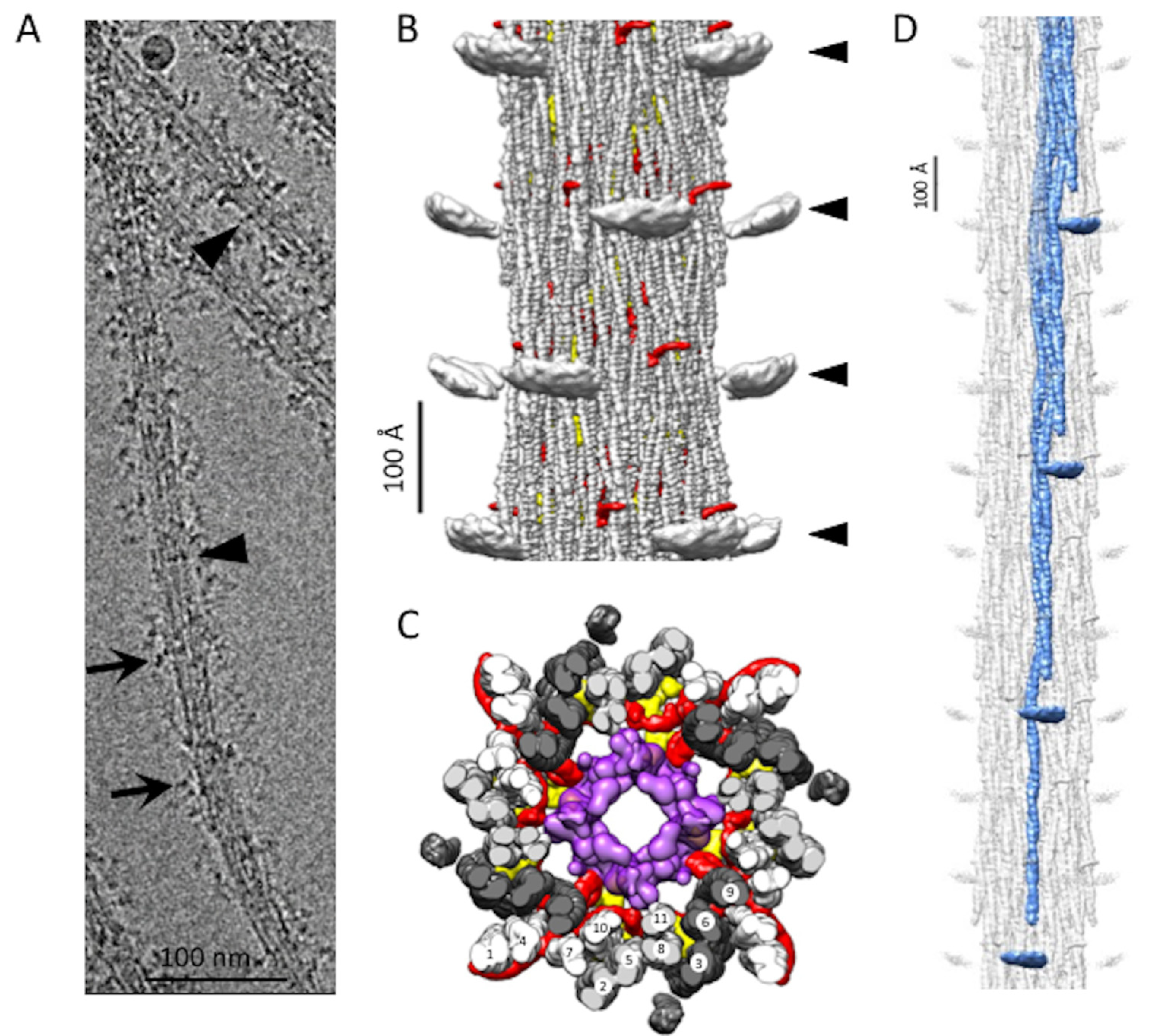
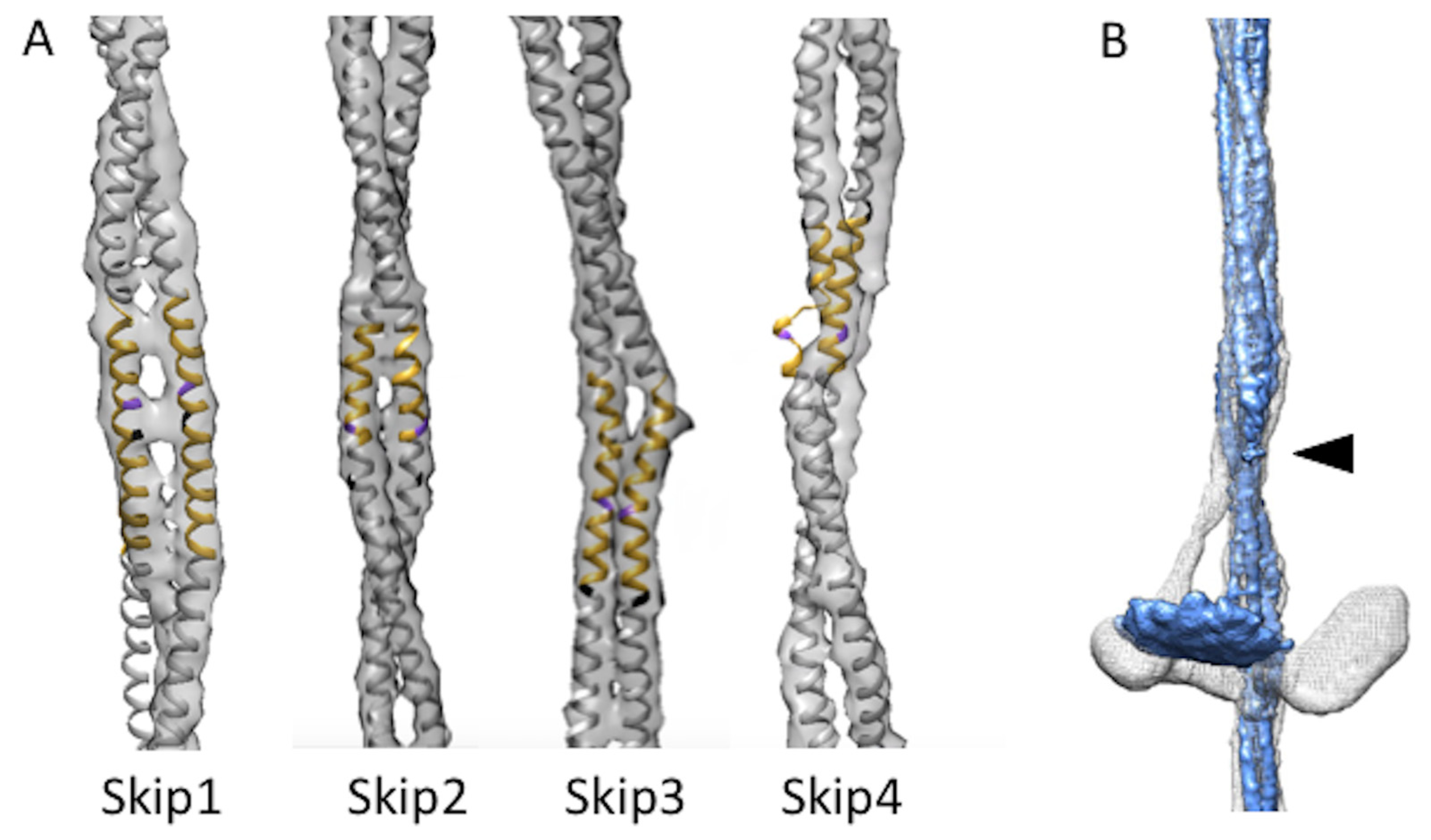
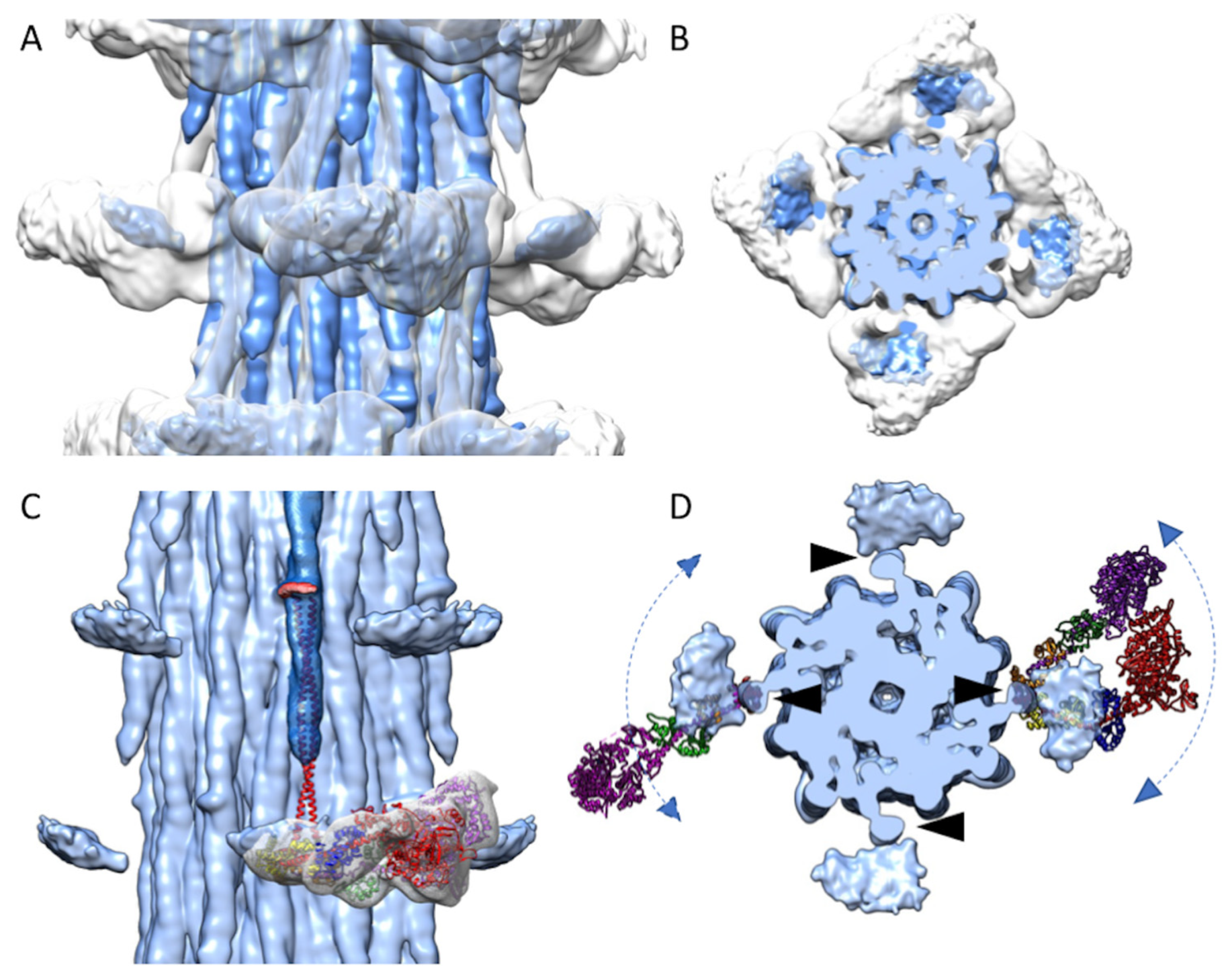
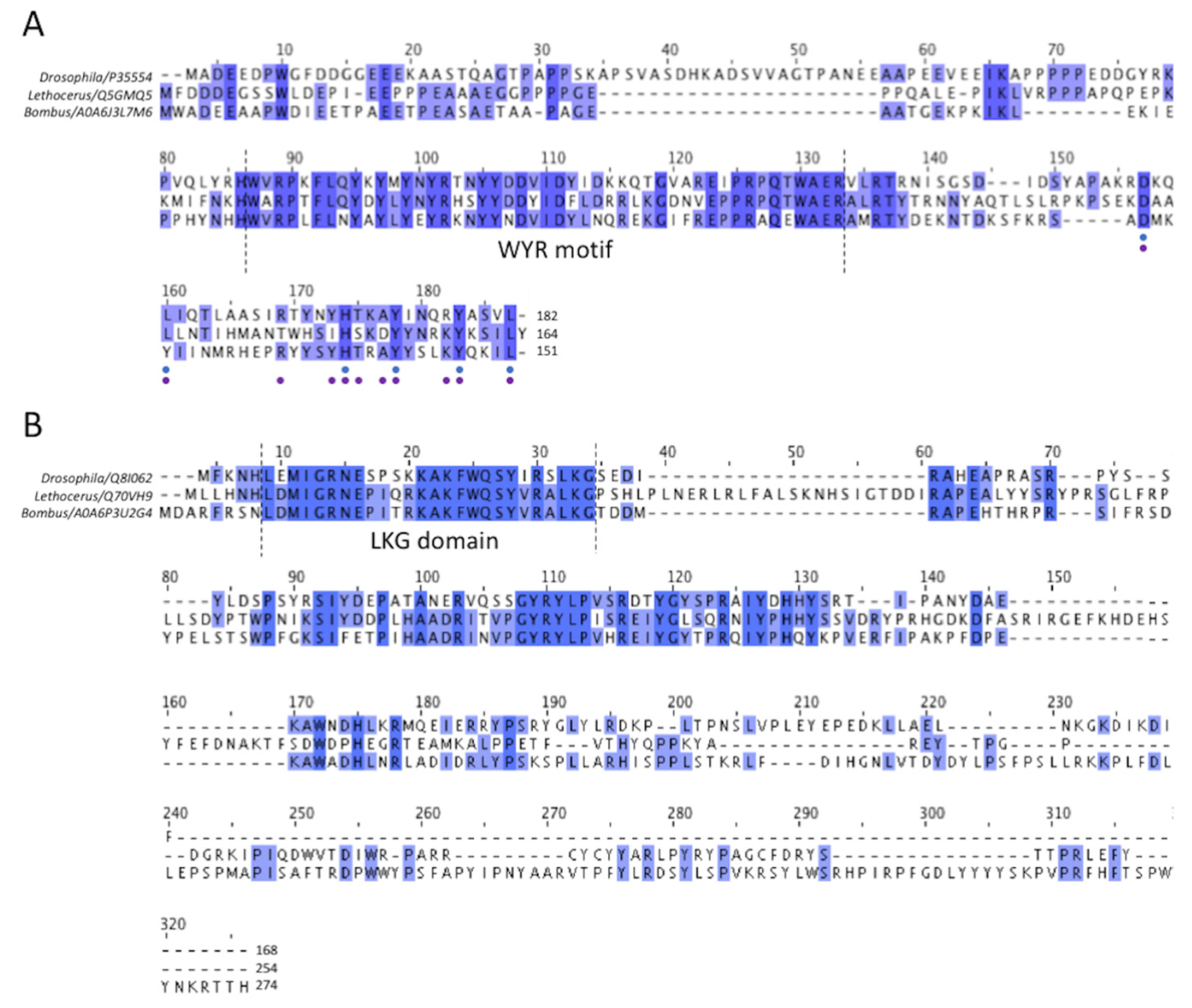
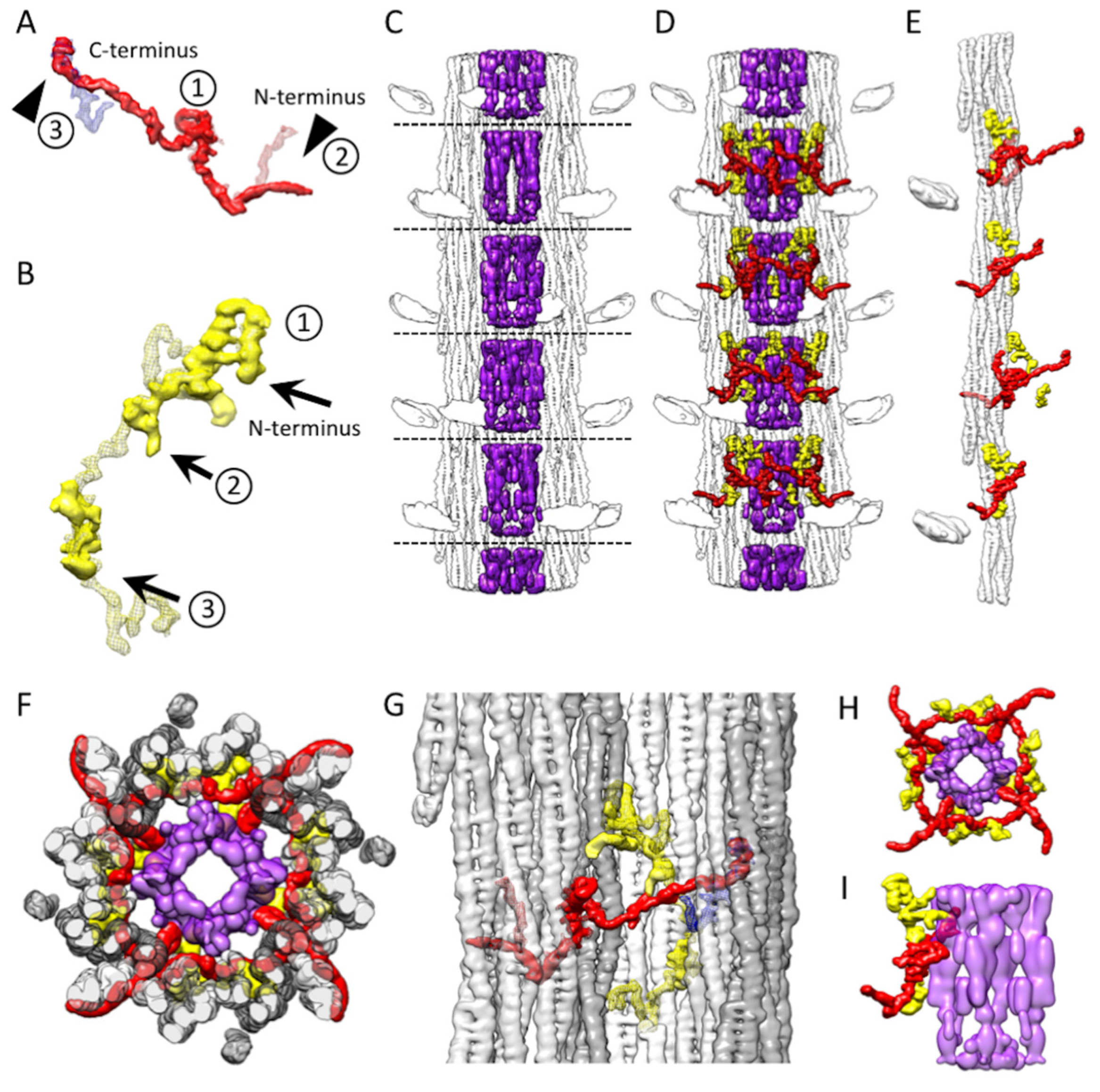
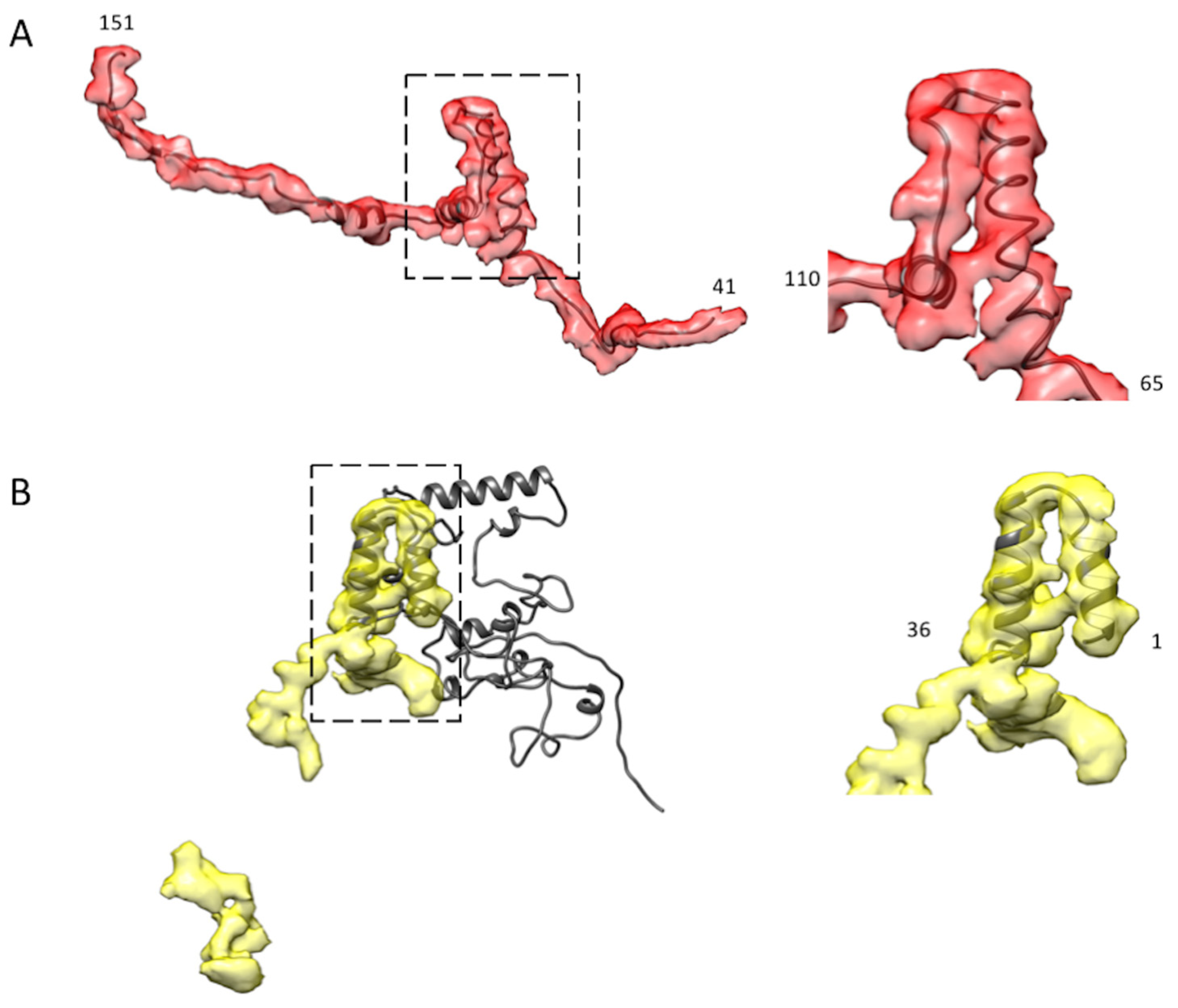
| Lethocerus | Drosophila | Bombus | |
|---|---|---|---|
| Helical rise (Å) | 147.038 | 148.826 | 147.533 |
| Helical twist (˚) | 33.98 | 33.86 | 34.05 |
| Thick Filament Protein § | Accession Number for Peptides | Species | # Myosin Molecules per Molecule ± SD (n = 7) | Number of Peptides Detected | Phosphorylation Site |
|---|---|---|---|---|---|
| Myosin heavy chain | A0A6P5HR22; A0A6P3TVX4 | B. terrestris | 0.50 ± 0.00 | 189 | |
| Myosin essential light chain | A0A6P3UB85 | B. terrestris | 0.59 ± 0.12 | 12 | |
| Myosin regulatory light chain | A0A6P8MQT; A0A6P3UC24 | B. bifarius; B. terrestris; | 1.45 ± 0.46 | 17 | S 62, T 36, T 36 + T 38 |
| Flightin | A0A6J3L7M6 | B. vosnesenskii | 4.16 ± 0.43 | 5 | |
| Myofilin | A0A6P3U2G4 | B. terrestris | 1.25 ± 0.07 | 28 | S 140 |
| Paramyosin | A0A6P3TYQ7 | B. terrestris | 3.29 ± 0.38 | 85 | S 872 |
| Mini-paramyosin | A0A6P5HKR2 | B. terrestris | 37.93 ± 11.75 | 19 | |
| Twitchin/Projectin | A0A6P8MB74 A0A6P5I285 | B. bifarius; B. terrestris | 20.32 ± 8.60 | 349 | |
| Obscurin | A0A6P3DZQ5 A0A6P3D8J7 A0A6P3UZW6 | B. impatiens B. terrestris; | 47.98 ± 29.44 | 97 | |
| Titin | A0A6J3LFW1 A0A6P5HR09 | B. vosnesenskii; B. terrestris | 33.72 ± 17.88 | 179 | S 4918 |
| Titin | A0A6P3URE2 A0A6P3U365 A0A6J3KGZ5 | B. impatiens; B. terrestris; B. vosnesenskii | 10.75 ± 13.44 | 68 | |
| Titin isoform X1 | A0A6P3TXU4 | B. terrestris | 13.66 ± 6.61 | 21 |
Disclaimer/Publisher’s Note: The statements, opinions and data contained in all publications are solely those of the individual author(s) and contributor(s) and not of MDPI and/or the editor(s). MDPI and/or the editor(s) disclaim responsibility for any injury to people or property resulting from any ideas, methods, instructions or products referred to in the content. |
© 2022 by the authors. Licensee MDPI, Basel, Switzerland. This article is an open access article distributed under the terms and conditions of the Creative Commons Attribution (CC BY) license (https://creativecommons.org/licenses/by/4.0/).
Share and Cite
Li, J.; Rahmani, H.; Abbasi Yeganeh, F.; Rastegarpouyani, H.; Taylor, D.W.; Wood, N.B.; Previs, M.J.; Iwamoto, H.; Taylor, K.A. Structure of the Flight Muscle Thick Filament from the Bumble Bee, Bombus ignitus, at 6 Å Resolution. Int. J. Mol. Sci. 2023, 24, 377. https://doi.org/10.3390/ijms24010377
Li J, Rahmani H, Abbasi Yeganeh F, Rastegarpouyani H, Taylor DW, Wood NB, Previs MJ, Iwamoto H, Taylor KA. Structure of the Flight Muscle Thick Filament from the Bumble Bee, Bombus ignitus, at 6 Å Resolution. International Journal of Molecular Sciences. 2023; 24(1):377. https://doi.org/10.3390/ijms24010377
Chicago/Turabian StyleLi, Jiawei, Hamidreza Rahmani, Fatemeh Abbasi Yeganeh, Hosna Rastegarpouyani, Dianne W. Taylor, Neil B. Wood, Michael J. Previs, Hiroyuki Iwamoto, and Kenneth A. Taylor. 2023. "Structure of the Flight Muscle Thick Filament from the Bumble Bee, Bombus ignitus, at 6 Å Resolution" International Journal of Molecular Sciences 24, no. 1: 377. https://doi.org/10.3390/ijms24010377
APA StyleLi, J., Rahmani, H., Abbasi Yeganeh, F., Rastegarpouyani, H., Taylor, D. W., Wood, N. B., Previs, M. J., Iwamoto, H., & Taylor, K. A. (2023). Structure of the Flight Muscle Thick Filament from the Bumble Bee, Bombus ignitus, at 6 Å Resolution. International Journal of Molecular Sciences, 24(1), 377. https://doi.org/10.3390/ijms24010377







